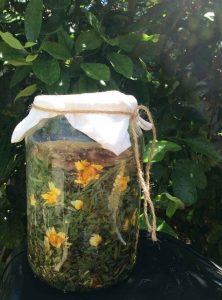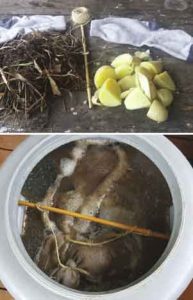Who is the best person to advise how to grow food naturally? A Natural Farmer of course! They grow food for a living and if they get it wrong they can quite literally lose the farm. So when I began to grow fruit and vegetables in my own back garden I turned to the wisdom of natural farmers. In doing so I have totally transformed my approach to suburban gardening.
Natural Farming around the World
There are many different types of natural farming around the world, but all aim to produce high quality food in an economically frugal and environmentally regenerative way. Saving both money and the planet. Sounds like a great idea right?
Natural farming movements have typically emerged in response to concerns about the environmental impact of modern agricultural methods. Biodynamics, which began in the 1920’s, is often cited as being the first modern attempt to develop a farming system that worked with nature (1).
After the Second World War, the “Green Revolution” resulted in an unprecedented application of advances in science and technology to world food production. Agriculture had become truly industrialised and whilst the increased harvests were nothing short of miraculous, growing concerns were emerging about the economic and environmental sustainability of some of these practices (2.) This sparked a renaissance in natural farming during the progressive 1960’s and 1970’s.
The seminal work of a Japanese farmer Masanobu Fukuoka and his 1975 book “One Straw Revolution” inspired many farmers to apply greater mindfulness to the interconnectivity of life (3). Fukuoka reportedly once warned: “If we throw Mother Nature out of the window, she comes back in the door with a pitchfork.”
In Australia our very own response to industrialised agriculture was the now worldwide Permaculture movement pioneered by Bill Mollison and David Holmgren. (4) Meanwhile in South Korea, Cho Han-Kyu developed Korean Natural Farming to provide Asian farmers with alternatives to expensive imported fertilisers and pesticides (5). Similar motivations led to Subhash Palekar to develop Zero Budget Natural Farming (ZBNF) in India. This system is reportedly not only repairing damaged soils but enabling farmers to break free of a debt-cycle linked to an alarming increase in suicides (6).
Today, as we face an escalating global environmental crisis, many people are finding the voices of these natural farming pioneers to be more compelling than ever before.
Gardening like a Natural Farmer
As gardening consumers, it’s easy for us to be seduced by shiny bottles promising “Miracle Grow” or “Rapid Kill”. The truth is that we don’t need them. Purchasing synthetic chemicals produced in a factory and transported to industrial sized warehouses is not only expensive, it inevitably produces a massive carbon footprint. Applying synthetic fertilisers and pesticides can also be detrimental to the heath of humans and the environment (7). As environmental awareness grows amongst Australian consumers, many gardeners are looking to make better choices.
Natural Farmers provide a wonderful but often untapped source of inspiration. Many of their techniques and recipes are freely available for us to try and most are quite easily applied to even the smallest suburban garden. You may be surprised at just how many of the ingredients are already in your pantry or garden. You may even be throwing some of them away! Other ingredients can be purchased cheaply at the supermarket or foraged sustainably from the local community and environment. With just a little knowledge you can transform everyday items into a range of inexpensive gardening inputs.

Waste fruit, vegetables, and fish can all be fermented into fertilisers. Egg shells can be transformed into liquid calcium solution and the left-over bones from the Sunday roast turned into calcium phosphate. Plants with herbal and insecticidal qualities can be boiled, fermented or tinctured into natural plant medicines and pesticides. Rice, milk, mashed potato, molasses and raw sugar are all ideal foods to cultivate beneficial micro-organisms. Manures from the local hobby farm can be value-added to make microorganism-rich applications. Even weeds become valued ingredients for making fertilisers and microorganism solutions. Two of the cheapest and easiest of these recipes accompany this article for you to experiment with.
By following the recipes of natural farmers I have transformed my shed into an apothecary of sustainable home-made gardening solutions. I’ve saved money on buying inputs and I’ve greatly reduced my household waste. My garden is also developing into an increasingly diverse and balanced ecosystem. I have far fewer pests and disease. My ornamental plants are thriving and my vegetable patch is feeding my family with a regular supply of healthy organic produce.
Thanks to the wisdom of natural farmers I’ve discovered that gardening doesn’t have to cost the earth.
Edible Fertiliser Recipe
Fermented Plant Juice (FPJ) is an Edible Fertiliser from the Korean Natural Farming (KNF) tradition (8). Most KNF inputs are edible which makes them a very safe option for suburban gardeners.

Ingredients
Raw Sugar and Unwashed Young Leaves of Edible Plants (Try weeds like Dandelion, Purslane, Nettle).
Method
Chop leaves and massage with equal weight of raw sugar. Pack the mixture tightly into three quarters of a glass jar and poor a thin cap of sugar over the top. Cover with a paper towel and leave in a dark spot for a week.
The raw sugar will draw out the liquid from the leaves through the process of osmosis. The natural biome on the unwashed leaves and sugar will encourage fermentation.
After a week, drain the syrup from the solids. Dispose of the solids in your compost bin. Refrigerate the liquid or add extra sugar to make it shelf-stable. Apply as frequently as desired to the foliage and/or soil by diluting a teaspoon in a large watering can
Microorganism Solution

Microorganisms are central to the success of all Natural Farmers. JADAM Indigenous Microorganism Solution comes from Korea but was designed to enable even the poorest farmers in the Third World to improve their soil and crops (9). JADAM is an acronym which roughly translates as “People who are like Nature”.
Ingredients
Leaf Litter/Humus/Compost (Handful)
Boiled Potatoes (Handful)
De-Chlorinated Fresh Water (70 Litre)
Sea Water (2 Litres)
Method
Put leaf litter/humus/compost and potatoes in separate socks or stockings with a stone in each to weigh them down in the water.
Suspend socks in the middle of the barrel. Massage socks into the water and leave for around 36-48 Hours (temperature dependent) or until disk of scum forms. This indicates a maximum number of micro-organisms or “peak bubble”.
Dilute heavily and apply to your soil so that it penetrates deep into the earth. Applying during rain will assist with this process.
If you live far from the sea you can replicate sea water by adding 35g of sea salt to 1L of water
References:
(1) W Lockerstz, “Organic Farming – An International History”, Tufts University, Massachusetts, USA, October 2007, Chapter 2, Pages 9-30.
(2) B. Glaeser Ed., “The Green Revolution Revisited: Critique and Alternatives.”, Volume 2 2011, Routledge, Page 1.
(3) M. Fukuoka, “The One-Straw Revolution: An Introduction to Natural Farming”, The New York Review of Books, 04 November 2009.
(4) B. Mollison, “Permaculture, A Designers Manual”, Reprinted October 1999, Tagari Publications, Tyalgum Australia.
(5) P. Besnard, “Mr Cho Biography”, https://natural-farming.weebly.com/mr-cho.html
(6) P Jebaraj, “What is Zero Budget Natural Farming?”, The Hindu, 28 July 2019.
(7) W. Aktar, D. Sengupta, A. Chowdhury, “Impact of pesticides use in agriculture: their benefits and hazards.”, Slovak Toxicology Society SETOX, 2009.
(8) J Cho, “Cho’s Natural Farming: Recipes and Instructions for Use”, (Translation: Insung Hoang, PhD), Chapter 3, Fermented Plant Juice (FPJ), pages 14-22.
(9) Y Cho, JADAM Organic Farming: The Way to Ultra-Low-Cost Agriculture, JADAM, 1 January 2016, V2, JADAM Indigenous Microorganism Solution (JMS), page 157.
Related Articles:
Garden Journaling – Slow down to tune in.
As we move through the year and our gardens evolve, there's something magical about documenting the journey. Garden journaling is an art that enables…
The Importance of building soil health for a biodeverse, productive garden
Creating a thriving garden that not only sustains itself but also contributes to the broader ecosystem requires more than just sunlight and water.…



